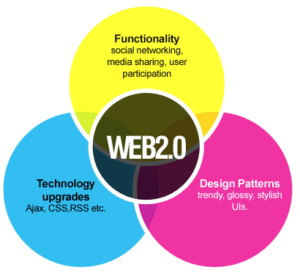Web 1.0 –> Web 2.0 –> Web 3.0
Within the ever-changing landscape of the World Wide Web, the transition from Web 1.0 to Web 3.0 represents not just advances in technology but also a significant impact on human thought processes, actions, and patterns of learning. Teachers, like Jackie Gerstein, see links between the development of the web and the transformation in education, moving from Education 1.0 to the anticipated Education 3.0. This blog article explores Gerstein’s metaphor, analyzing how the transition to Web 3.0 has affected education and identifying the stakeholders who have benefited and suffered from this digital transformation. Gerstein’s metaphor highlights how people and the web have a symbiotic relationship in which both have an impact on the growth and content of the other. Education has evolved in a way that is similar to the Web 1.0, which was defined by static web pages, Web 2.0, which was interactive and collaborative, and Web 3.0, which is intelligent and semantic. This progression represents a shift away from traditional, one-way schooling (schooling 1.0) and towards a personalized, dynamic, and participatory learning environment (Education 3.0).

Web 2.0 has undoubtedly enhanced the convenience of my life, offering a plethora of creative tools, visually engaging YouTube content for complex topics, and collaborative platforms like Gizmo and Google products that empower students with unique exploration experiences. However, this convenience comes at a significant health cost. While utilizing these tools, it’s impossible to overlook the pervasive presence of advertisements strategically integrated by companies aiming to generate revenue. One might suggest simply ignoring these advertisements, but the issue extends beyond surface-level distractions. Companies and social media applications have assembled dedicated teams to develop products specifically designed to manipulate user behavior, urging continuous engagement with their platforms.According to Derek et al., Web 2.0 and Education 2.0 are essential elements in the transition to Education 3.0. Wide-ranging, cross-institutional opportunities characterise this stage of education, where students actively participate as makers of shared knowledge artefacts, incorporating social networking’s significant influence beyond immediate activities. The metaphor and article by Gerstein highlight the necessity of a parallel evolution in education, calling on educators to recognise the shifting terrain, comprehend how students connect, communicate, and learn, and modify their methods accordingly.
The shift in education from antiquated methods (Education 1.0) to the revolutionary possibilities of Web 2.0 (Education 2.0) is reflected in the evolution of the Web from version 1.0 to version 3.0. Nevertheless, many educational procedures still have their roots in Education 1.0, even in spite of the developments. Gerstein’s observations compel teachers to assess their techniques critically and consider the necessary change.While the foundations for a broader transformation are laid by Web 2.0, it predominantly serves to enhance traditional educational approaches. Education 2.0 integrates technologies like blogs, podcasts, and social bookmarking to foster collaboration between educators and students, as well as among students themselves. The impending shift to Web 3.0, however, induces a sense of anxiety due to the magnitude of change it heralds. In the progression from web 1.0 to 3.0, learners initially gained knowledge, while web 2.0 technologies provided platforms for sharing, discussion, and collaboration. Web 3.0 is envisioned as more open, interconnected, and notably intelligent, with self-learning capabilities. The advantages of Web 3.0 include personalized and collaborative learning opportunities, driven by innovation and creativity.

Hi dida,
Your blog about how education has changed with the internet is really interesting. You talked about how the internet has gone from being basic (Web 1.0) to interactive (Web 2.0) to smart and connected (Web 3.0). I liked how you mentioned the good things about Web 2.0, like cool tools and YouTube videos, but also the not-so-good stuff like ads and how they try to keep us hooked. Your call for teachers to think about how they teach and make sure all students can benefit is important. Keep up the good work!
hey Navneet, Thank you so much for taking the time to read my blog and offer your thoughts! That the conversation on the evolution of Web 1.0 to Web 3.0 in education was interesting to you makes me very happy. It has been quite interesting to see how the internet has changed education throughout the years.